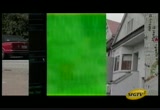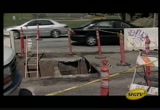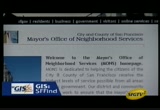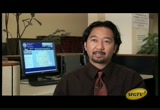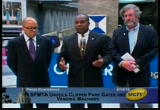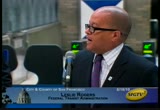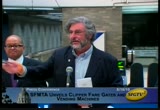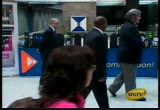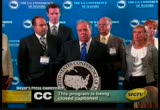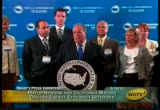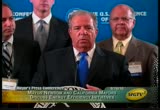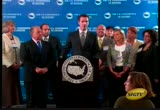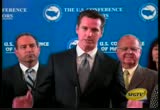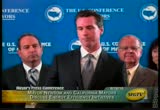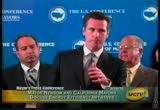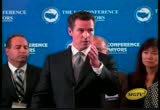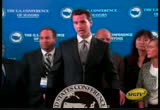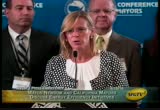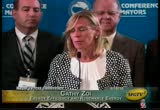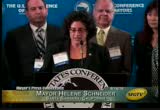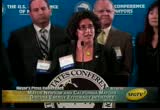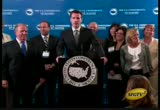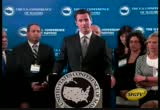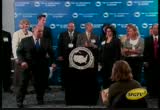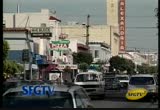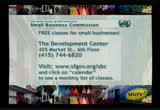tv [untitled] August 31, 2010 4:00pm-4:30pm PST
5:00 pm
screen. you get the traffic for the streets the number of crimes for a police district in a period of time. if the idea of combining the different layerce of information and stacking them on top of each other to present to the public. >> other types of gis are web based mapping systems. like google earth, yahoo maps. microsoft. those are examples of on line mapping systems that can be used to find businesses or get driving directions or check on traffic conditions. all digital maps. >> gis is used in the city of san francisco to better support what departments do. >> you imagine all the various elements of a city including parcels and the critical
5:01 pm
infrastructure where the storm drains are. the city access like the traffic lights and fire hydrants. anything you is represent in a geo graphic space with be stored for retrieval and analysis. >> the department of public works they maintain what goes on in the right-of-way, looking to dig up the streets to put in a pipe. with the permit. with mapping you click on the map, click on the street and up will come up the nchgz that will help them make a decision. currently available is sf parcel the assessor's application. you can go to the assessor's website and bring up a map of
5:02 pm
san francisco you can search by address and get information about any place in san francisco. you can search by address and find incidents of crime in san francisco in the last 90 days. we have [inaudible] which allows you to click on a map and get nchldz like your supervisor or who your supervisor is. the nearest public facility. and through the sf applications we support from the mayor's office of neighborhood services. you can drill down in the neighborhood and get where the newest hospital or police or fire station. >> we are positive about gis not only people access it in the office but from home because we use the internet. what we used to do was carry the
5:03 pm
large maps and it took a long time to find the information. >> it saves the city time and money. you are not taking up the time of a particular employee at the assessor's office. you might be doing things more efficient. >> they have it ready to go and say, this is what i want. >> they are finding the same things happening on the phone where people call in and ask, how do i find this information? we say, go to this website and they go and get the information easily. >> a picture tells a thousand stories. some say a map >> good morning, everyone, and thank you for joining us. it is my pleasure to be here with our regional fta administrator and our
5:04 pm
commissioner from san francisco who sits on the metropolitan transportation commission. we have a new development in terms of the muni metro system, one of which is the beginning of the card installation system. we have nine stations that will be receiving newgate's. and we will be adding another 19 disabled fare gates. what we are attempting to do here is replace the infrastructure that has well tapped is useful life in terms of our fair gates, and we are cobbling that at the same time with a nuclear program, which you all should be aware of and which is the regional smart card that will be used throughout the area for public transit trips in the region. the new ticket vending machines -- we have purchased 40 of those ticket vending machines. customers should be able to go to any metro station and purchase tickets that can be
5:05 pm
used on all of the systems in the metro region. they are multi-lingual machines. they speak in english as well as spanish and chinese, so we are very excited to be here today. again, 30 years worth of work that these dates have done it, and they have done all that they can carry in over 700,000 people, and these new dates will hopefully be here in the next 25 or 30 years serving as public transportation services here in the city, getting to and from their loved ones, getting to their job, getting to education, so we do not look at these gates as just being steel and rubber and labels. we look at them as an instrument to help people achieve their dreams, and today is an important day. we expect to have the total system outfitted by the end of october. we would not be here if it were
5:06 pm
not from the parks department, with federal stimulus dollars that came to us from the fda. the project had been sitting on the shelf for quite some time here at the agency, and we were fortunately able to fast for this project through our partnership with the mtc and the clipper program, through federal stimulus dollars that were presented to us by president obama's economic recovery program. it was clearly a partnership that got us here today, and it is i guess a signal of future unveilings we will be doing over the next couple of months over the -- with other projects that will be coming to fruition. we started this work a few years ago as it related to the clipper card. we started work as it relates to the trolley buses being rehabilitated. we have a host of projects that we are implementing at this time to get our system in a good state of repair, and today is just one of them. with that, i would like to turn it over to our regional administrator -- regional fta.
5:07 pm
>> i am especially pleased to join you here today and celebrate this wonderful partnership. this project has been forwarded with $11 million of federal stimulus dollars, and that is only one portion of the upward of $70 million in stimulus money that came to the mta here. we're very pleased to be here today. i would analogize this project almost to that of fine wine. nothing before its time. we have been involved with translink program. we are almost there. not only did the recovery money provide and create and retain jobs across the country, it provided that additional
5:08 pm
infrastructure funding to get us over the hump. again, we are pleased to join with you today, and congratulations to both of our partners. thank you very much. >> here it is -- this is the clipper card, so everybody, have a good look at that. i think it is a very handsome looking card. you will see the logo on all the cards, on all the machines. you just put the cards down, and you are on your way to wherever your going -- wherever you are going, and given the -- how shall i say it -- the particular special environment of the bay area, the fact that we can all get around with the same card is a wonderful thing, and mtc is
5:09 pm
delighted -- believe me, i have been there a long time. it is a great delight and a real treat to be able to have this happen today, so i hope everybody will have a chance to use the cards and enjoy it. thank you very much, and i'm delighted to be here. >> clearly, there is a group of folks we have to recognize here. we would not be here today if it was not for the folks in the trenches with ft thec s andfmta and federal transit administration -- those are the folks that really brought this to fruition. they have a lot more hard work to do, as when you bring on any complicated technology like this. it does have its growing pains, and we will experience those, but you have a commitment from the mtc and mta that we will try to make this is painless as possible. i think it is a great day to have these new fare gauges, just
5:10 pm
another indication of how the mta is reinventing capital dollars to make sure the system is reliable and efficient and on time. we're going to have the project manager of m from theta -- from the mta take us over to the ticket machine. they will give us a demonstration of how the machines work, and they will give us cards from the new gates. we will come back and use the clipper cards on the new fare gates. >> i want to thank you all for being here today.
5:11 pm
i'm the mayor of the city of long beach, california, and i'm also a trustee of the u.s. conference of mayors. mayors from all over this great state have assembled here today to talk about the energy efficiency conservation block grant program. this is a program that started in 2007, and it delivers funds directly to cities to be able to improve their energy efficiency, reduce their carbon footprint, and as important, create new jobs in our community. i will just give you a little background in this really quickly. program was originally thought of in 2005 when the u.s. conference of mayors launched its climate protection agreement. the agreement is a landmark measure across the country. the u.s. conference of mayors initiated it. it began with 141 mayors. it now has 1044 mayors that have
5:12 pm
signed on to the climate protection agreement, committing to reduce our climate footprint in each one of our communities. the energy block grant program has been an integral part of that. it gives us the resources to reduce our energy consumption and reduce our carbon footprint, and as i said, it also creates jobs. it has been the result of a lot of people working together, but i do need to thank the speaker of the house, nancy pelosi, who worked hard to make this program a reality, and we would not be here today except for her efforts. on behalf of american cities, i want to thank the speaker for her commitment and diligence. without her help, as i said, this would not be here. i also want to thank president obama and his administration for his support of the program as well as the american recovery and reinvestment act, which is also to fund a number of new
5:13 pm
initiative projects in a number of our cities. as i said, we are here to work for efficiency and reduce our carbon footprint. in my city, we are investing about $4 million to accelerate private city efforts to reduce energy efficiency in our city structures as well as some of our residential buildings, and we will hear in a moment from the mayors of other cities about what they're doing, but this program is exactly what we need to continue. it is really the only major funding source we have to be able to improve our efficiency and work on climate change issues, particularly by reducing our carbon footprint. we know that a successful plan for reducing u.s. energy consumption is grounded in local action, and all across this country, it has been demonstrated that local government can take action that is effective and not only reduces our impact on the environment but also puts people back to work.
5:14 pm
we have been leading the nation in this effort, and i have to tell you, it has been an innovative program that provides the flexibility needed to local governments, and it is the kind of thing that must be carried on in the future. i now would like to introduce a friend of mine and no stranger to all of you, san francisco mayor gavin newsom, who is going to discuss what things have been going on right here in san francisco with this program. mayor newsom: thank you for your stewardship and leadership in bringing us all together. i thank all the mayors that are here and all of you for taking the time to be here. from our perspective, there are few things more important than this. at the end of the day, what we are really talking about, what we are organizing around is job creation and economic development, reducing the costs not only to government, but reducing the cost to individual
5:15 pm
businesses, large and small, that want to reduce their energy bill at the same time we advance our environmental principles and advance our collective goals. as many of you know, san francisco has a low global climate action plan. basically all that is is the formal plan that 3043 other mayors -- at 1043 other mayors have signed to robot greenhouse gas unless it -- emissions to 1990 levels by 2012. we have done that through -- in small part in terms of that reduction. that is energy efficiency. that is the low hanging fruit. that is the easy part of this effort. we have some very ambitious goals nationwide. about half of that, most objective analysis has been done
5:16 pm
that shows that half of that can be achieved through energy efficiency, so you do not need something in the order of magnitude. just common sense. swapping out that level, taking the old boiler and replacing it, taking that call don t --hat -- that caulk gun in different respects. the think about it is it is so obvious and so easy but we were not achieving our goals until the president and speaker got together and demanded we get some block grants. we needed some energy development block grants and we needed some autonomy. let me conclude by making a jobs case, and i was making this just a moment ago, on why this matters.
5:17 pm
we get about $7.7 million through block grants, and we are using that jobs now program, the federal subsidy for direct jobs. 3600 jobs we have created. they are going out and doing energy audits, so we are doing free energy audits, and then we are using all these grants, and then we are providing free resources for folks to actually deal with their boilers and other issues, but here is the big idea, and this is something -- if we put $1 billion -- you do not need to take $1 billion credit. you can just leverage the percentage that is arguably of to what $1.8 trillion that is just sitting there on the sidelines. just to leverage that money is guaranteed, like we do small business association loans, and start getting people to work today on energy efficiency and create real jobs. here's how we do it -- you get $1 billion just making this
5:18 pm
case, and you invest into coal, and generate about 870 jobs. sounds great, but you could generate 1000 or 1500 jobs in nuclear energy, but if you want to create more jobs and wealth and opportunity, 1900 jobs in wind or about 3300 jobs, but the big game changer is retrofitting and green building. 7000 jobs for that $1 billion investment. you can just use the money that is sitting in all these financial institutions and guarantee those loans and get people back to work, doing the energy efficiency work that all these mayors are doing quite successfully, and you do it in rural and suburban areas, not just these big metro areas. get people to work, particularly those in the building and construction trades, those that have the highest rate of unemployment. that is the opportunity, and
5:19 pm
that is where we are trying to communicate, what we are trying to organize around. this is a win on all fronts, and this is being demonstrated in cities large and small across the country. one of the successes of the stimulus plan is the focus on jobs and this economy. i want to thank everybody who is here and think cathy and her team for their leadership, and think mayor foster for helping bring all of you here to our city and county of sentences go. thank you. >> thank you, mayor newsom. >> i would like to bring our partner to the podium, the efficiency secretary, cathy joey. >> thank you all for coming. three quick points. on behalf of the president and secretary chu, let me underscore
5:20 pm
that energy efficiency is central to economic recovery from our perspective. we need to bleed into all the energy potential. americans spend $1.10 trillion on utility bills in their businesses and homes per year. we can become more efficient. that is $200 billion we can save, and we can create jobs while doing it. for every billion that gets invested, 7000 jobs. this program will go on to create more. we love our partnership with the mayors. the mayors are working directly in investing money in cities on the ground, in buildings, schools, and communities. this program has 2350 grantees from across america that have programs under way this summer, demonstrating that investments in clean energy, green energy, helps economies. watch where the projects are.
5:21 pm
some of them are wildly innovative. some just make good sense. there are sensible, money saving light bulbs that should have gone in a long time ago. putting new elie de -- led technology into traffic lights, which create safer streets. there are literally thousands of projects under way. take note of what those are. share information. in washington, we are very excited about our partnership. we are very excited about the energy savings that will come from this program and in the future. thank you all. >> thank you, madam secretary. finally, we will have another major address you with what is going on in her city. she is from the city of santa barbara. >> thanks you. i appreciate the opportunity to speak here. i think mayor newsom for your leadership from the beginning.
5:22 pm
hopefully, we can see some allocations after the first- round is moved around. that is important for congress to see the investment of this as not just an expenditure. the city of santa barbara has a little over 100,000 people. our funding was about $658,000. we did lighting efficiency projects in four parks as well as some heating, ventilating, and air-conditioning retrofits in eight city buildings. the park's alone are saving 140,000 kilowatt hours annually, a savings of $88,000. the eecbg grants, coupled with other funding we did with our municipal building energy audit, is sitting as $150,000 in our general fund. along with the jobs that are being created with this project, when i came in and met with a
5:23 pm
number of mayors this morning, the first question has been how is your budget going. what is going on with your general fund and your public works? in our city, if we are able to save $150,000 a year that would have gone to paying for energy bills, which can put it into police officers, firefighters, parks and recreation -- the municipal services people have come to expect. that is helping us get over this recession on top of giving private-sector jobs. it is saving energy at the same time. it is a great program. we need to keep it coming to the cities. i appreciate the leadership of the u.s. conference of mayors for having this meeting today. >> thank you, mayor schneider. are there any questions from anyone? >> i was just wondering about --
5:24 pm
speaking of leveraging grants, clean energy loans. can some of that money come to this program? >> can you repeat that? i did not get all of that. i am sorry. >> we just passed with a lot of fanfare and no follow-up, not because of good intentions but because of fannie and freddie. i was going to use the wrong adjective. [laughter] their unwillingness to be supportive of the program -- they are wrong. this is right. the president is right. congress, by and large, is right. all these mares are ready to go to do what -- all these mares are ready to go to do what the secretary started. the first program was done in berkeley years ago.
5:25 pm
it is simple. the company is not going to provide enough resources. how the finance those upgrades? -- how do you finance those upgrades? you can amortize them over the life of your mortgage in a way that gives billions of dollars for the retrofitting of buildings. ours is the largest in the united states. we passed a more than $150 million appropriation. we were ready to go. we had dozens of people who had already gotten approval. then the word came out that fannie and freddie no longer would allow these because of the weight it relates to first orleans. i will not bore you with it. -- because of the way it relates to first liens. i will not bore you with it. it is a step to the screen economy. it is up to the folks running
5:26 pm
fannie and freddie. we need to see something change quickly. our attorney general filed suit, to his credit. mayors across the country are ready to voice, as well as governors, when we have a sympathetic ear from the administration and the department. we just need some folks there to right this wrong. >> any other questions? thank you all for being here. we appreciate it.
5:27 pm
56 Views
IN COLLECTIONS
SFGTV2: San Francisco Government Television Television Archive
Television Archive  Television Archive News Search Service
Television Archive News Search Service 
Uploaded by TV Archive on

 Live Music Archive
Live Music Archive Librivox Free Audio
Librivox Free Audio Metropolitan Museum
Metropolitan Museum Cleveland Museum of Art
Cleveland Museum of Art Internet Arcade
Internet Arcade Console Living Room
Console Living Room Books to Borrow
Books to Borrow Open Library
Open Library TV News
TV News Understanding 9/11
Understanding 9/11